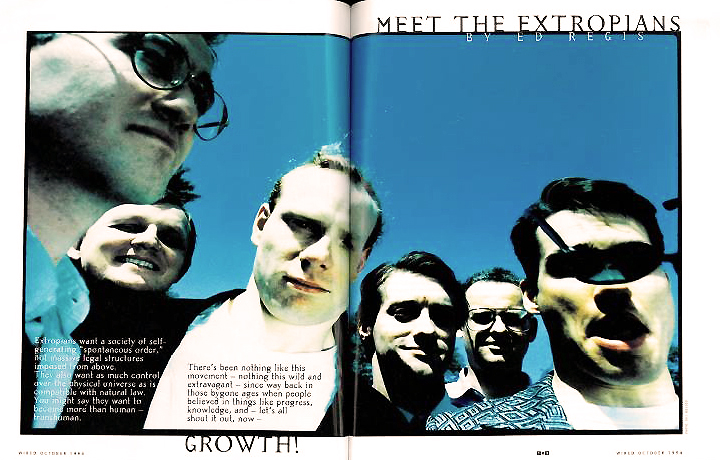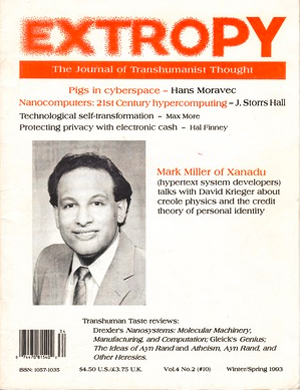The Extropian Roots of Bitcoin

Bitcoin is booming, but not every enthusiast knows that the cryptocurrency has roots in a radical, futurist philosophy that started to bloom in the California of the 80s.
Hal Finney, a Bitcoin pioneer and the first person to ever receive a Bitcoin transaction, was cryonically preserved by the Alcor Life Extension Foundation on August 28, 2014. Please don’t say to Hal friends that he “passed away” or worse – cryonics enthusiasts hope to be revived by future science, in a few decades or centuries down the stream of time.
Cryonics was (and still is) frequently discussed on the Extropians mailing list. The list (now called Extropy-chat ) started in the 90s with the Internet and is one of the oldest mailing lists still active. The Extropy Institute , founded in California in the 80s a few years before the Internet, published a print journal (image below) for a few years. They say death and taxes are the two things you can’t escape, but escaping death and taxes is precisely what Extropy was all about in its early days.
Hal was a frequent participants in the Extropian online discussions of cryonics, life extension, space colonization, nanotechnology, artificial intelligence, mind uploading (the transfer of human consciousness from biological brains to alternative high-performance substrates), and the technical, social and political aspects of cryptography. Julian Assange lurked, and occasionally participated.
I joined the list in the 90s after reading a Wired article titled “Meet the Extropians .” The list has been one of my main sources of intellectual nourishment ever since, and I made a lot of good friends there. I never met Hal in person, but we often corresponded, and I treasure the emails that I received from him.

“Long-time [Extropy] member – and honored cypherpunk and Bitcoin pioneer – [Hal Finney] was declared clinically dead this morning and is now being cryopreserved,” Extropy founder Max More , now Alcor CEO, announced to the list. “Hal, I know I speak for many when I say that I look forward to speaking to you again sometime in the future and to throwing a party in honor of your revival.”
Who is John Galt?
The discussions of cryptography on the list were informed by a strong Libertarian stance that was characteristic of the early phase of Extropy, similar to the philosophy of Ayn Rand’s hero John Galt. The ideological framework is outlined in Max More’s “The Principles of Extropy,” and the following passages are especially relevant here:
“Extropy means supporting social orders that foster freedom of communication, freedom of action, experimentation, innovation, questioning, and learning. Opposing authoritarian social control and unnecessary hierarchy and favoring the rule of law and decentralization of power and responsibility.”
“Extropic societies are open societies that protect the free exchange of ideas, the freedom to criticize, and the liberty to experiment. Coercively suppressing bad ideas can be as dangerous as the bad ideas themselves. Better ideas must be allowed to emerge in our cultures through an evolutionary process of creation, mutation, and critical selection. The freedom of expression of an open society is best protected by a social order characterized by voluntary relationships and exchanges.”
It’s interesting to note that these words could seem too sedate and watered down to many hardcore Extropian Libertarian of the 80s and 90s. On the other hand, many flavors of radical futurism have emerged since the 90s, which are distributed all over the political spectrum.
Perry Metzger was (and still is) a staunch, uncompromising Extropian Libertarian. Metzger defines himself as “Transhumanist Market Anarchist, Systems and Security Geek, Molecular Manufacturing Semi-Pro,” and he is the owner of the Cryptography mailing list.
Not all cryptography related discussions on the Extropy list were political though – there was a fair deal of hardcore technical and mathematical detail (and even more so on the Cryptography lost), offered by top experts including Hal (who participated in the early development of PGP ), Nick Szabo, and Wei Dai.
At the Extropy Institute’s fifth annual conference Extro-5, in 2001, Szabo spoke of smart contracts that solved the problem of trust by being self-executing, and property embedded with information about who owns it. For example, the key to a car sold on credit might only operate if the monthly payments have been made. These ideas are clear precursors of “Bitcoin 2.0” technologies such as Ethereum.
Who is Satoshi Nakamoto?
It’s interesting to note that Hal Finney, Nick Szabo, and Wei Dai have been rumored to be Satoshi Nakamoto, the mystery man who announced Bitcoin in October 2008 on Metzger’s Cryptography list. Hal Finney had made attempts to create his proof of work based currency, called RPOW, while Nick Szabo and Wei Dai had proposed similar e-cash frameworks called, respectively, Bit gold and b-money.
All three have denied being Satoshi Nakamoto, but the rumors persist. Nick Szabo and Wei Dai are still suspected to be but two of the many pseudonyms used by the invisible genius who also used the Satoshi Nakamoto pseudonym – the now 86 years old Nobel Prize winner John Nash of “A Beautiful Mind ” fame.
Also read: Nick Szabo (Bitcoin founder Satoshi Nakamoto?) Breaks his Silence with a Tweet
I don’t know how seriously we should take those rumours. Most certainly, those persons have the intellectual bandwidth to pull something like Bitcoin out of the unseen realm of arcane mathematics, but the allegations still seem too far-fetched to me. However, I suspect that Satoshi Nakamoto may have been lurking or even participating, under other pseudonyms, on the Extropy list.
The Legacy of Extropy
 I started a discussion on the Extropy list to gather thoughts and recollections to use in this article.
I started a discussion on the Extropy list to gather thoughts and recollections to use in this article.
“I don’t remember much of the discussions, but they were often pretty extensive,” says Anders Sandberg of the Future of Humanity Institute at Oxford University, and continues:
“Both anarchocapitalist ideas and how to implement PPL using smart contracts (old issues of [the Extropy print magazine] might have a few illuminating articles), technical discussions about protocols and of course hardware worries about rod logic computers cracking codes. I think the key insight was that crypto could act as a primitive for building awesome things.”
“The Extropy archives will indeed be a goldmine for future historians,” says Mike La Torra, a Director of the Institute for Ethics and Emerging Technologies .
Hal Finney had similar thoughts in 2006:
“It’s possible that someday this material will be seen as representing the birth of ideas which turn out to be key to the further development of humanity.”
Hal also said :
“[T]he original extropians mailing list had a policy of quasi-secrecy with regard to list archives. As a result, much of that free-wheeling discussion has been lost, an information exchange which many of us remember as among the most dynamic and engaging we have ever encountered. It may never be possible to reconstruct and restore those lost archives, but eventually, the list policy changed, and we should make sure that what remains is not lost.”
I think a lot of ideas that will have a huge impact of the world originated on the Extropy list or at least found an early greenhouse there. Bitcoin, which seems well on its way to having a huge impact, is but one of the first, and I am persuaded that other Extropian ideas will have a huge impact when their time comes.
Images from Alcor, Extropy Institute, and Shutterstock.